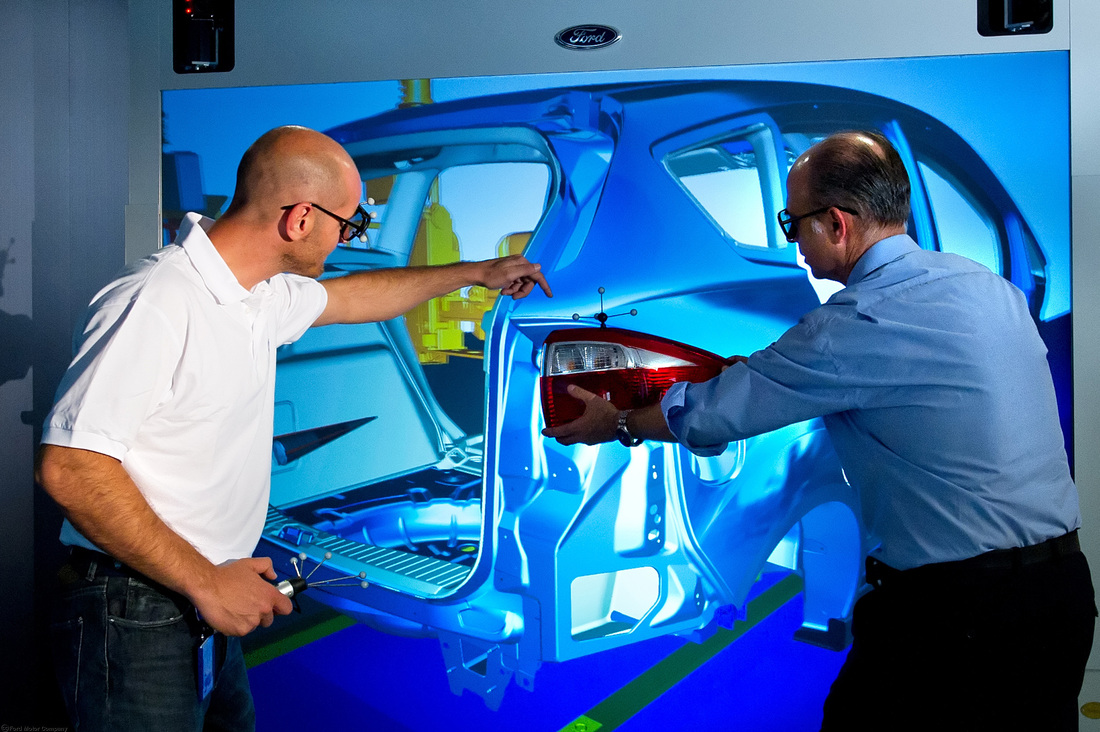Are Virtual Factories the Future of Manufacturing?
The world is more connected than ever before. In the past 15 years, virtual meetings and online communication have saved businesses untold amounts of money and resources. A similar evolution is taking place in manufacturing facilities today with the 3-D virtualization of factories.
At the Hannover Messe trade show, taking place April 8 to 12 in Hannover, Germany, demonstrations of the so-called “factory of the future” will be on display at the Fraunhofer Society stand in Hall 2.
This flagship virtual factory will enable visitors to learn about the “Green Carbody Technologies – InnoCaT” innovation alliance, supported by the German Federal Ministry of Education and Research. The alliance has set itself the goal of significantly improving the resource and energy consumption of the entire manufacturing process, and of organizing it to be more easily planned and monitored, by using the automotive body-shop as an example.
The virtual environment will be based on an automotive plant, and will show attendees the numerous potential resource and energy savings in the tool-shop, press-shop, vehicle body-shop or paint-shop. The “factory of the future” will function with spontaneously networked and real-time-capable software.
These systems give visual feedback from the entry on a monitor displaying a 3-D reconstruction of an automotive component, such as a bumper. Using a non-contact, gesture-recognition system (think Tom Cruise in the movie Minority Report) developed by BMW Group, a quality assurance professional can examine and document flaws in a component simply by pointing. This allows the professional to remain at his desk and virtually interact with any testing object, saving time and effort.
As futuristic as this sounds, the hardware requirements are surprisingly common: a standard computer and two Microsoft Kinect systems – comprising a camera and 3-D sensors – are enough.
“Until now testers have to note all detected flaws, leave their work station to go to the computer terminal, navigate several screens and then enter the flaw location and type. This is laborious, time-consuming and prone to error,” says Alexander Schick, a scientist at the Fraunhofer Institute for Optronics, System Technologies, and Image Exploitation in Karlsruhe, Germany.
Gesture control significantly improves testers’ working conditions and saves time – employees can remain at their workstation and interact directly with the testing object. “If the bumper is fine, they swipe across it from left to right. In case of a flaw, they point to its location,” Schick explains.
The factory virtualization process is finding greater popularity worldwide, as large-scale operations begin adopting the technology to streamline production. Last year, Ford Motor Company announced its European facilities will be implementing virtual factory systems to improve assembly-line efficiency.
“Virtual factories will enable Ford to preview and optimize the assembly of future models at any of our plants, anywhere in the world. With the advanced simulations and virtual environments we already have at our disposal, we believe this is something Ford can achieve in the very near future,” José Terrades, simulations engineer at Ford of Spain, explained.
Various Fraunhofer Society innovations and exhibits will be part of Hannover Messe’s theme of Integrated Industry. Solutions for intelligent data processing in crisis management systems will also be a subject at the Fraunhofer exhibit in Hall 2, which looks at early detection of impending damage in deep-sea drillings, a new broadband sensor system for monitoring drinking water quality, and a sensor network with mobile robots for disaster management, triggered by earthquakes, floods, or industrial accidents.
This flagship virtual factory will enable visitors to learn about the “Green Carbody Technologies – InnoCaT” innovation alliance, supported by the German Federal Ministry of Education and Research. The alliance has set itself the goal of significantly improving the resource and energy consumption of the entire manufacturing process, and of organizing it to be more easily planned and monitored, by using the automotive body-shop as an example.
The virtual environment will be based on an automotive plant, and will show attendees the numerous potential resource and energy savings in the tool-shop, press-shop, vehicle body-shop or paint-shop. The “factory of the future” will function with spontaneously networked and real-time-capable software.
These systems give visual feedback from the entry on a monitor displaying a 3-D reconstruction of an automotive component, such as a bumper. Using a non-contact, gesture-recognition system (think Tom Cruise in the movie Minority Report) developed by BMW Group, a quality assurance professional can examine and document flaws in a component simply by pointing. This allows the professional to remain at his desk and virtually interact with any testing object, saving time and effort.
As futuristic as this sounds, the hardware requirements are surprisingly common: a standard computer and two Microsoft Kinect systems – comprising a camera and 3-D sensors – are enough.
“Until now testers have to note all detected flaws, leave their work station to go to the computer terminal, navigate several screens and then enter the flaw location and type. This is laborious, time-consuming and prone to error,” says Alexander Schick, a scientist at the Fraunhofer Institute for Optronics, System Technologies, and Image Exploitation in Karlsruhe, Germany.
Gesture control significantly improves testers’ working conditions and saves time – employees can remain at their workstation and interact directly with the testing object. “If the bumper is fine, they swipe across it from left to right. In case of a flaw, they point to its location,” Schick explains.
The factory virtualization process is finding greater popularity worldwide, as large-scale operations begin adopting the technology to streamline production. Last year, Ford Motor Company announced its European facilities will be implementing virtual factory systems to improve assembly-line efficiency.
“Virtual factories will enable Ford to preview and optimize the assembly of future models at any of our plants, anywhere in the world. With the advanced simulations and virtual environments we already have at our disposal, we believe this is something Ford can achieve in the very near future,” José Terrades, simulations engineer at Ford of Spain, explained.
Various Fraunhofer Society innovations and exhibits will be part of Hannover Messe’s theme of Integrated Industry. Solutions for intelligent data processing in crisis management systems will also be a subject at the Fraunhofer exhibit in Hall 2, which looks at early detection of impending damage in deep-sea drillings, a new broadband sensor system for monitoring drinking water quality, and a sensor network with mobile robots for disaster management, triggered by earthquakes, floods, or industrial accidents.
SOURCE: Thomas.Net




The future of manufacturing looks pretty interesting, according to this article. Can’t wait to get to the future! https://goo.gl/pTUvUk